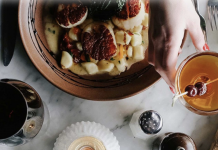“Wine is such a fantastic thing that makes it an interesting life,” says Bill Spence, who has made it his life’s work to create this “fantastic thing,” most notably Sauvignon Blanc in New Zealand. The area is known for this varietal, and he was there as part of the revolution that put the country on the wine map.
As brand ambassador for his family’s Matua Valley Wines (pronounced “mah-too-ah”), which means ‘“most senior one” or “head of the family” in Maori, Bill Spence is spreading the love of the white wine noted for its “zing.” It’s a refreshing sipper on its own, of course, and also pairs well with grilled chicken, pork or white fish. Sauvignon Blanc pairs with any seafood, suggests Spence, such as scallops and prawns. “The essence cuts the oily character from salmon and brings out the flavor of prawns—and it’s good with a nice creamy sauce.”
Sauvignon Blanc’s profile can be described as having red pepper and gooseberry characteristics as well as tropical fruit overtones and fresh cut grass, tomato stalks, and grapefruit or limes—I suppose we writers need words to describe flavors. But a note on the winery’s website introducing the founders, winemaker and staff reads: “Forget your cats and gooseberry bushes, your Middle-Earth mountains and picture postcard landscapes. Because wine is made by people, not places.”
And some of those people are brothers Bill and Ross Spence, who grew up around wine, since their father was part of the early West Auckland winemaking community that established the industry in New Zealand. Ross, the older of the two, studied oenology at Fresno State in California and Bill majored in viticulture at New Zealand’s Massey University. After they returned with their new ideas, “Our father had decided, ‘You do it my way or the highway,’” says Bill—so to the “highway” they went.
They worked at some other wineries for a few years in the early days and planted their own Sauvignon Blanc in 1969, producing their first bottle in 1974. Why did they choose Sauvignon Blanc as opposed to another white grape? They planted a lot of different varieties and Sauvignon Blanc showed promise, says Spence. When Robert Mondavi came over to New Zealand and consulted with Spence, Mondavi said he called the varietal Fume Blanc in California, so Spence initially called it by that name in New Zealand. “Then came confusion,” notes Spence, “so we went back to Sauvignon Blanc.” Then it took off.
Over the years, the brothers got along pretty well, “We definitely had conflicts but we’d voice our opinion and carried on with work,” says Spence. And Spence’s family grew beyond bloodline. He has said a wine company is like a family, “… and back then an extended family. All the wine companies—we all helped each other—if something broke you could help each other even though you were competitors,” he says. And the Matua family still includes original employees.
What was one of the most memorable moments over the years? “The biggest moment was when we won the (first) trophy for Sauvignon Blanc. … We didn’t have large properties in Marlborough. It was rewarding for us since we were the first,” says Spence. And today, Sauvignon Blanc is New Zealand’s most widely planted varietal.
Since that first trophy, Matua has won many awards. Under the direction of current winemaker Nikolai St. George, accolades include the 2012 International Wine & Spirits Competition in London: New Zealand Producer of The Year and 2013 San Francisco Wine Competition Best Sauvignon Blanc and Double Gold.
“A very talented winemaker who manages the rest of his team from a distance—lets them do their own thing,” says Spence of St. George. “He often lets the wine do its own thing, too, lets it follow its own track … rather than playing/fiddling with it.”
“As much as we have new technology to help us, the basic principle is the same.” They research different yeast and how it affects Sauvignon Blanc, aiming for a wine with not as much grapefruit flavor but still with green grassy characteristics, notes Spence. “Our wine is not heavy in the grapefruit, more pineapple and melon,” he says.
In addition to the flagship white, Matua also imports a Pinot Noir. One of his personal favorites right now is this Pinot Noir from Marlborough, which works well as a warm-weather red. “It’s light and refreshing,” says Spence. “I put it in the fridge for an hour; it has very little oak and it’s a wine that stands up for itself.” He suggests pairing it with pasta—venison and red sauce with tomato and onion and herbs is a favorite.
“The wine industry is forever changing and improving,” notes Spence. “I just think that the American market is becoming more aware of different styles from all over the world. … A palate can change,” he says, noting that there are some wines he enjoyed in his youth that he wouldn’t touch now. “My biggest thing is if you don’t like that style, at least experiment and know what you do like.”
Bill focused much of his early activity on vineyard development, but his outgoing personality made him the logical choice for sales and marketing. An early champion for export, Bill became the inaugural chairman of the New Zealand Wine Guild. Matua Valley Wines was purchased in 2001 by Foster’s Wine Estate, and being the brand ambassador allows him to focus on representing the brand on a global scale. (His brother Ross has retired.) “Selling it brought in a lot of funds to expand,” says Spence. “It’s great that I started the company and I still have the opportunity to have input into the company and spread the word.”
The winery’s tagline states: “You could say we’ve changed the way the world drinks wine. Has it gone to our heads? Hardly. But it has fired us up to do more.” So while the Sauvignon Blanc and Pinot Noir from Marlborough are currently the two wines in the Matua portfolio available locally, the winery hopes to increase export options in 2016, so we’ll stay tuned. In the meantime, you can see if a swirl and sip of their Sauvignon Blanc calls to mind pineapple and melon flavors, or rather the folks who had a hand in making it.







